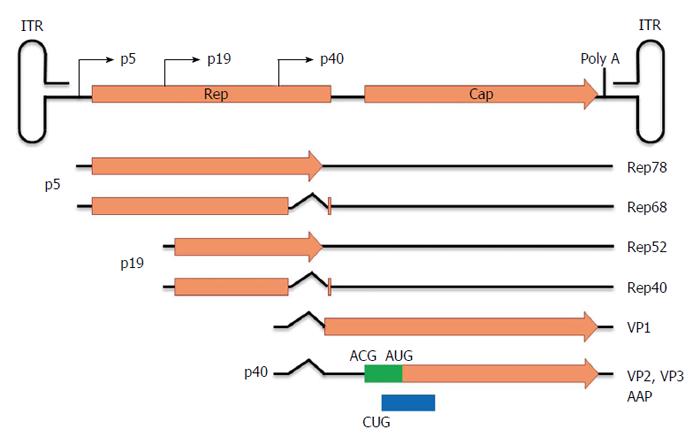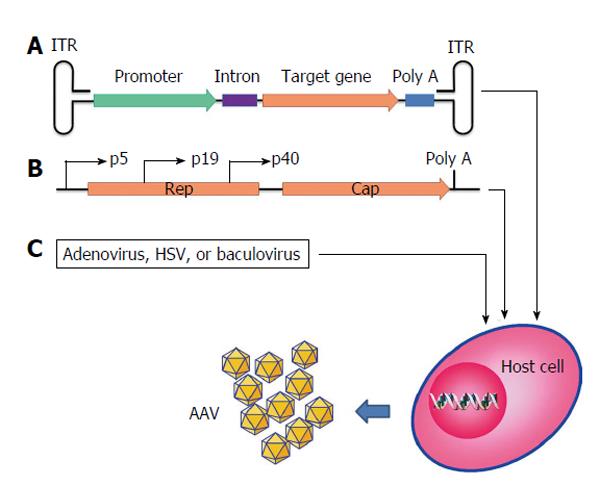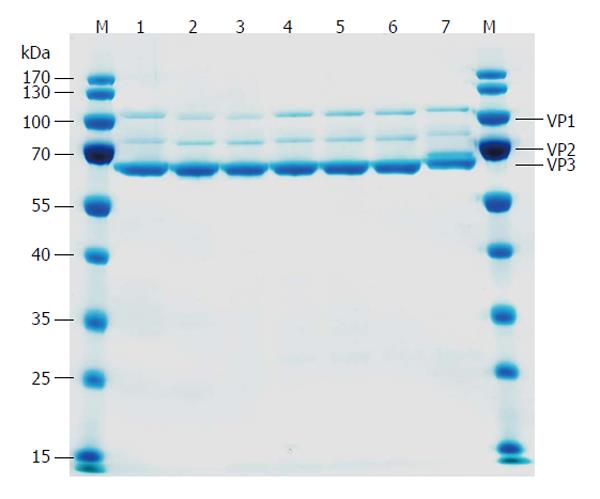Copyright
©The Author(s) 2015.
World J Med Genet. Aug 27, 2015; 5(3): 28-45
Published online Aug 27, 2015. doi: 10.5496/wjmg.v5.i3.28
Published online Aug 27, 2015. doi: 10.5496/wjmg.v5.i3.28
Figure 1 Diagram of adeno-associated virus genome depicting the inverted terminal repeats, promoters, polyadenylation sequence, and mRNAs coding for rep, cap, and assembly-activating protein proteins.
The rep open reading frames codes for four rep proteins (Rep78, Rep68, Rep52, and Rep40) that are synthesized from mRNAs transcribed from the p5 and p19 promoters. Rep78 and Rep68 have site-specific endonuclease, DNA helicase, and ATPase activities that are required for adeno-associated virus (AAV) DNA replication[148-150]. Rep52 and Rep40 contain helicase activity and are required for packaging AAV DNA into the capsids[151]. VP1, VP2, and VP3 are synthesized from mRNA transcribed from the p40 promoter. To main a 1:1:10 ratio of VP1:VP2:VP3 for virus particle assembly, AAV uses an alternative splicing mechanism for VP1 and a less efficient start codon (ACG) for VP2 to lower their protein levels, yet keeps high efficiency start codon for VP3[152]. The N-terminal sequence present in VP1 contains a phospholipase A2 domain that is required for AAV infectivity[114,115,153]. In addition, the VP2/VP3 mRNA codes for an assembly-activating protein (AAP) from a weak CTG start codon but in a different reading frame[154]. AAP facilitates nuclear import of the major VP3 capsid protein and promotes assembly and maturation of the capsid, but AAP is not present in the mature capsid. ITR: Inverted terminal repeat; Poly A: Polyadenylation.
Figure 2 Diagram of adeno-associated virus vector production.
A: The expression cassette containing promoter, intron, target gene, and polyadenylation sequence is flanked with adeno-associated virus (AAV) inverted terminal repeats (ITRs); B: AAV rep and cap sequences without ITRs are provided in trans; C: helper virus can be adenovirus, herpes simplex virus (HSV), or baculovirus depending on the production system used. Once these three components are introduced into a host cell under proper conditions, AAV vectors will be produced.
Figure 3 SimplyBlue SafeStaining of purified adeno-associated virus vectors on SDS-PAGE gel.
Seven purified lots of adeno-associated virus (AAV) vectors at the amount of 1e + 11 vg per lane were loaded on a 10% Tris-glycine gel. The gel was stained with SimplyBlue SafeStain Kit (Invitrogen). Lanes 1, 4-6: AAV9; lanes 2 and 3: AAV5; lane 7: AAV8.2. AAV capsid proteins VP1, VP2, and VP3 are indicated; M: Protein ladders.
- Citation: Chen H. Adeno-associated virus vectors for human gene therapy. World J Med Genet 2015; 5(3): 28-45
- URL: https://www.wjgnet.com/2220-3184/full/v5/i3/28.htm
- DOI: https://dx.doi.org/10.5496/wjmg.v5.i3.28















